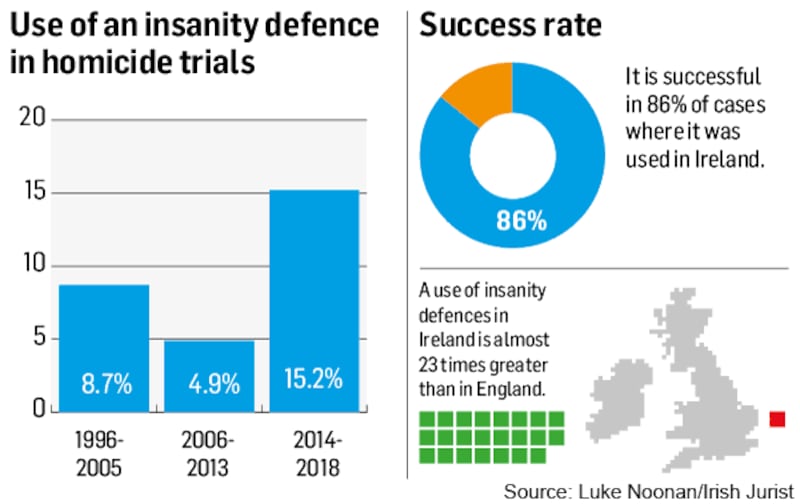The use of insanity as a defence in Irish homicide trials has increased more than threefold in recent years, new figures show.
The defence is used in Irish courts 23 times more often than in England, the country with the most comparable criminal insanity legislation.
As the use of the insanity defence has increased, the rate at which it is accepted by a jury has remained relatively stable. The figures show 86 per cent of homicide cases involving an insanity plea result in a jury finding the defendant was not legally responsible for the crime.

Luke Noonan, a PhD student in the University College Cork school of law, examined 648 homicide trials that took place in the Central Criminal Court between 1996 and 2018.
Between 1996 and 2006, before the law around criminal insanity was drastically reformed, 8.7 per cent of homicide trials involved an insanity defence.
This dropped to 4.9 per cent between 2006 and 2013, before it more than tripled to 15.2 per cent between 2014 and 2018, according to Mr Noonan's study, funded by the National Research Council and published in the Irish Jurist.
Legally insane
Data from the Courts Service suggest the trend is accelerating. In 2019, the most recent year for which figures are available, just under 25 per cent of murder trials involved an insanity plea.
In the vast majority of homicide cases involving an insanity plea, the prosecution concedes the defendant was legally insane at the time of the killing. The jury is told there is no disagreement between the prosecution and defence, and it is expected to return a not guilty by reason of insanity verdict.
Mr Noonan said a change in the law, which meant people do not face automatic detention in the Central Mental Hospital after pleading insanity, is the most likely explanation for the increase in such pleas.
“Prior to 2006, the law was that it was mandatory after an insanity verdict that you had to be detained,” he said. “Whereas after the passing of the 2006 Act, there was discretion given and not all people found not guilty by reason of insanity were detained in the Central Mental Hospital.”
Conditional discharge
The reason it took until 2014 for the increase to become evidence is that, under the original 2006 Act, patients in the CMH could not be granted a conditional discharge. This meant the review board could not attach mandatory requirements to their release such as having to live at a certain address and attend medical appointments.
The board either had to release patients unconditionally or keep them locked up. The result, according to Mr Noonan, was that it was less likely to release patients.
This changed in 2010 when an amendment was introduced to allow conditional releases. This made the board more likely to release patients and, as a result, made an insanity plea a more attractive option for defendants.
The disparity in the use of insanity defences between England and Ireland is possibly down to Ireland having a more "liberal" interpretation of the legal requirements for such a defence, Mr Noonan said.
It is also evident that defendants in England are more likely to rely on the defence of “diminished responsibility”, he added. Diminished responsibility can be used to argue a defendant is guilty of manslaughter but not murder. It is available in Irish law but rarely used.














